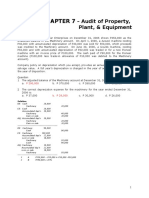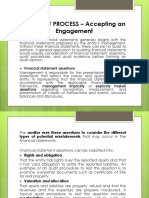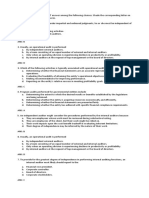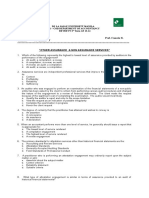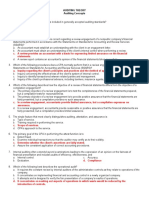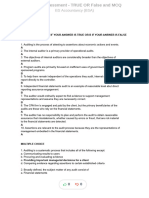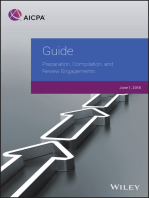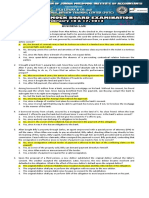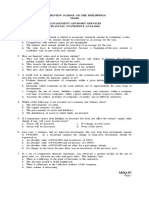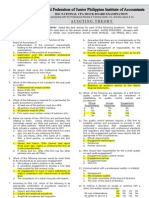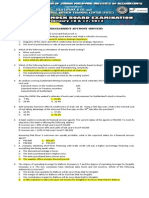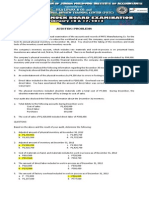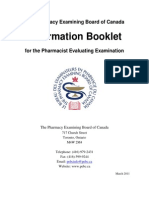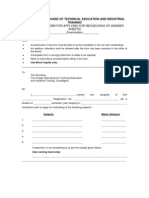Auditing Theory ch15
Auditing Theory ch15
Uploaded by
xxxxxxxxxCopyright:
Available Formats
Auditing Theory ch15
Auditing Theory ch15
Uploaded by
xxxxxxxxxOriginal Description:
Copyright
Available Formats
Share this document
Did you find this document useful?
Is this content inappropriate?
Copyright:
Available Formats
Auditing Theory ch15
Auditing Theory ch15
Uploaded by
xxxxxxxxxCopyright:
Available Formats
Other Assurance Services
MULTIPLE CHOICE:
1. A study and evaluation of internal control made in
connection with an annual audit is usually not sufficient
to express an opinion on an entity's internal control
because
a.
Weaknesses in the system may go unnoticed during the
audit engagement.
b.
A study and evaluation of internal control is not
necessarily made during an audit engagement.
c.
Only those controls of interest to the auditor are
reviewed, tested, and evaluated.
d.
Internal controls can change each year.
ANSWER:
2.
Of the following statements, which one does not describe a
distinction between the auditing standards and the
attestation standards?
a.
Unlike the auditing standards, the attestation
standards do not require the auditor to obtain an
understanding of the client's internal control system
b.
The attestation standards are broader in coverage than
the auditing standards.
c.
In performing an attest engagement, the CPA need not be
independent.
d.
In an attest engagement, unlike an audit, generally
accepted accounting principles are not the standard
used to measure the reasonableness of assertions.
ANSWER:
3.
Each page of a non-public entity's financial statements
reviewed by an accountant should include the following
reference:
a.
See Accountant's Review Report.
b.
Reviewed, No Accountant's Assurance Expressed.
c.
See Accompanying Accountant's Footnotes.
d.
Reviewed, No Material Modifications Required.
ANSWER:
4.
A CPA may accept an engagement to apply agreed-upon
procedures to prospective financial statements provided
a.
All parties have agreed on the procedures to be
applied.
254
Chapter 15 Other Assurance Services
b.
c.
d.
The CPA has previously audited the entity for which the
agreed-upon procedures are to be applied.
Users have participated in establishing the nature and
scope of the engagement, distribution of the report is
limited to the users involved, and the prospective
statements include a summary of significant
assumptions.
The set of agreed-upon procedures include, at a
minimum, a study and evaluation of the existing
internal control.
ANSWER:
5.
Which of the following is not a distinction between a
compilation and a review?
a.
The CPA must be independent as a prerequisite to
performing a review engagement, but need not be
independent to perform a compilation.
b.
In conducting a review, the CPA must obtain an
understanding of the client's internal control system;
but this is not necessary for a compilation engagement.
c.
Analytical procedures are applied in a review
engagement, but are not required in a compilation.
d.
A compilation offers no assurance, whereas a review
provides limited assurance.
ANSWER:
7.
The statement that "nothing came to our attention which
would indicate that these statements are not fairly
presented" expresses which of the following?
a.
Disclaimer of an opinion.
b.
Negative assurance.
c.
Negative confirmation.
d.
Piecemeal opinion.
ANSWER:
6.
255
During a compilation of a non-public entity's financial
statements, an accountant would be least likely to
a.
Omit substantially all of the disclosures required
by generally accepted accounting principles.
b.
Issue a compilation report on one or more, but not
all, of the basic financial statements.
c.
Perform analytical procedures designed to identify
relationships that appear to be unusual.
d.
Read the compiled financial statements and consider
whether they appear to include adequate disclosure.
ANSWER:
256
8.
Chapter 15 Other Assurance Services
When an independent CPA is associated with the financial
statements of a publicly held entity but has not audited or
reviewed such statements, the appropriate form of report to
be issued must include a(an)
a.
Compilation report.
b.
Disclaimer of opinion.
c.
Unaudited association report.
d.
Qualified opinion.
ANSWER:
9.
When an auditor issues an unqualified opinion on an entity's
internal control, it is implied that the
a.
Entity has not violated provisions of the Foreign
Corrupt Practices Act.
b.
Likelihood of management fraud is minimal.
c.
Financial records are sufficiently reliable to permit
the preparation of financial statements.
d.
Entity's internal control system is in conformity
with criteria established by its audit committee.
ANSWER:
10.
Which of the following statements best distinguishes a
forecast from a projection?
a.
A forecast contains one or more hypothetical
assumptions, whereas a projection reflects conditions
expected to exist.
b.
A projection is appropriate for general distribution to
third parties, whereas a forecast is more tentative and
should be restricted to those parties with whom the
client is negotiating directly.
c.
The CPA may review a financial forecast, but may only
compile a projection.
d.
A forecast reflects conditions expected to exist,
whereas a projection presents financial position,
results of operations, and cash flows given one or more
hypothetical assumptions.
ANSWER:
11.
If an accountant concludes that unaudited financial
statements on which the accountant is disclaiming an
opinion also lack adequate disclosure, the accountant
should suggest appropriate revision. If the client does
not accept the accountant's suggestion, the accountant
should
a.
Issue an adverse opinion and describe the appropriate
revision in the report.
Chapter 15 Other Assurance Services
b.
c.
d.
Make reference to the appropriate revision and issue a
modified report expressing limited assurance.
Describe the appropriate revision to the financial
statements in the accountant's disclaimer of opinion.
Accept the client's inaction because the statements
are unaudited and the accountant has disclaimed
an opinion.
ANSWER:
12.
Which of the following should not be included in an
accountant's standard report based upon the compilation of
an entity's financial statements?
a.
A statement that a compilation is limited to presenting
in the form of financial statements information that is
the representation of management.
b.
A statement that the compilation was performed in
accordance with standards established by the American
Institute of CPAs.
c.
A statement that the accountant has not audited or
reviewed the financial statements.
d.
A statement that the accountant does not express an
opinion but expresses only limited assurance on the
financial statements.
ANSWER:
14.
An accountant who reviews the financial statements of a
non-public entity should issue a report stating that a
review
a.
Is substantially less in scope than an audit.
b.
Provides negative assurance that the internal control
system is functioning as designed.
c.
Provides only limited assurance that the financial
statements are fairly presented.
d.
Is substantially more in scope than a compilation.
ANSWER:
13.
257
Of the following statements, which one is not a precondition
for performing attest services?
a.
The practitioner must be a certified public accountant.
b.
The practitioner must have adequate knowledge of the
subject matter.
c.
There are reasonable measurement and disclosure
criteria concerning the subject matter.
d.
The assertions are capable of reasonably consistent
estimation or measurement using such criteria.
ANSWER:
258
15.
Chapter 15 Other Assurance Services
In which of the following reports should a CPA not express
negative or limited assurance?
a.
A standard compilation report on financial statements
of a non-public entity.
b.
A standard review report on financial statements of a
non-public entity.
c.
A standard review report on interim financial
statements of a public entity.
d.
A standard comfort letter on financial information
included in a registration statement of a public
entity.
ANSWER:
16.
In accordance with SEC requirements, a publicly held company
has included interim financial information in its annual
report to shareholders. The independent auditor has
examined the annual financial statements and believes that
they fairly present financial position, results of
operations, and cash flows. The auditor, however, has not
applied limited procedures to the interim data. In drafting
the audit report covering the annual financial statements,
therefore, the independent auditor should
a.
Qualify the audit opinion for a scope limitation,
given failure to apply the limited procedures.
b.
Issue an unqualified opinion on the financial
statements followed by an explanatory paragraph stating
that the procedures were not applied.
c.
Disclaim an opinion given the material impact of the
interim financial information.
d.
Qualify the audit opinion and describe the limited
procedures in a separate paragraph explaining the scope
restriction.
ANSWER:
17.
Comfort letters are ordinarily signed by the
a.
Client.
b.
Client's lawyer.
c.
Independent auditor.
d.
Internal auditor.
ANSWER:
18.
Before performing a review of a non-public entity's
financial statements, an accountant should
a.
Complete a series of inquiries concerning the entity's
procedures for recording, classifying, and
summarizing transactions.
Chapter 15 Other Assurance Services
b.
c.
d.
Apply analytical procedures to provide limited
assurance that no material modifications should be
made to the financial statements.
Obtain a sufficient level of knowledge of the
accounting principles and practices of the industry
in which the entity operates.
Inquire whether management has omitted substantially
all of the disclosures required by generally accepted
accounting principles.
ANSWER:
19.
Which of the following procedures is not necessary in
conducting a review of interim financial information?
a.
Inquiry concerning the accounting system and any
changes in internal control.
b.
Application of analytical procedures to the interim
information.
c.
Inquiry of and obtaining written representations from
management concerning its responsibility for the
financial information and other matters.
d.
Confirmation of significant customer accounts
receivable as of the interim balance sheet date.
ANSWER:
21.
The objective of a review of interim financial information
is to provide the accountant with a basis for reporting
whether
a.
A reasonable basis exists for expressing an updated
opinion regarding the financial statements that were
previously audited.
b.
Material modifications should be made to conform with
generally accepted accounting principles.
c.
The financial statements are presented fairly in
accordance with standards of interim reporting.
d.
The financial statements are presented fairly in
accordance with generally accepted accounting
principles.
ANSWER:
20.
259
The accountant's report expressing an opinion on an entity's
internal control would not include a
a.
Brief explanation of the broad objectives and inherent
limitations of internal control.
b.
Specific date that the report covers, rather than a
period of time.
c.
Statement that the entity's control system is
consistent with that of the prior year after giving
260
Chapter 15 Other Assurance Services
d.
effect to subsequent changes.
Description of the scope of the engagement.
ANSWER:
22.
Comfort letters are ordinarily addressed to
a.
The Securities and Exchange Commission.
b.
Underwriters of securities.
c.
Creditor financial institutions.
d.
The client's audit committee.
ANSWER:
23.
Which of the following should be included in an accountant's
standard report based upon the review of a non-public
entity's financial statements?
a.
A statement that the review was performed in
accordance with generally accepted review
standards.
b.
A statement that a review consists principally of
inquiries and analytical procedures.
c.
A statement that the accountant is independent with
respect to the entity.
d.
A statement that a review is substantially greater in
scope than a compilation.
ANSWER:
24.
Engagements for the purpose of expressing an opinion on
internal control differ from the CPA's evaluation of
internal control as part of a financial audit in that
a.
In an engagement to express an opinion, the CPA is
examining and reporting on controls as of a specified
date, whereas in conducting a financial audit, the CPA
frequently tests controls for effectiveness over the
period covered by the financial statements.
b.
In conducting a financial statement audit, the CPA
expresses an opinion as to the operating effectiveness
of the client's internal control system, whereas in an
engagement to express an opinion on internal control,
the CPA addresses design and implementation of control
structure.
c.
In conducting a financial statement audit, the CPA is
concerned with general controls only, whereas in an
engagement to express an opinion on internal control,
the CPA tests both general and application controls.
d.
Scope limitations that affect a financial audit are
irrelevant in an engagement to express an opinion on
internal control.
Chapter 15 Other Assurance Services
ANSWER:
25.
Accepting an engagement to compile a financial projection
for a publicly held company most likely would be
inappropriate if the projection were to be distributed to
a.
A bank with which the entity is negotiating for a
loan.
b.
A labor union with which the entity is negotiating a
contract.
c.
The principal stockholder, to the exclusion of the
other stockholders.
d.
All stockholders of record as of the report date.
ANSWER:
29.
A modification of the CPA's report on a review of the
interim financial statements of a publicly-held company
would be necessitated by which of the following?
a.
An uncertainty.
b.
Lack of consistency.
c.
Reference to another accountant.
d.
Inadequate disclosure.
ANSWER:
28.
The CPA is asked to audit financial statements prepared on a
modified cash basis. This is acceptable provided the CPA
a.
Converts the financial statement to an accrual basis
before rendering an audit report.
b.
Qualifies the audit opinion for a departure from GAAP.
c.
Issues an adverse opinion.
d.
States clearly in the audit report that fairness was
evaluated within the framework of the other basis
rather than GAAP.
ANSWER:
27.
Each page of the financial statements compiled by an
accountant should include a reference such as
a.
See accompanying accountant's footnotes.
b.
Unaudited, see accountant's disclaimer.
c.
See accountant's compilation report.
d.
Subject to compilation restrictions.
ANSWER:
26.
261
When an independent accountant issues a comfort letter to an
underwriter containing comments on data that have not been
audited, the underwriter most likely will receive
262
Chapter 15 Other Assurance Services
a.
b.
c.
d.
A disclaimer on prospective financial statements.
A limited opinion on "pro forma" financial statements.
Positive assurance on supplementary disclosures.
Negative assurance on capsule information.
ANSWER:
30.
31.
Which of the following professional services would be
considered an attest engagement?
a.
A management consulting engagement to provide CBIS
advice to a client.
b.
An engagement to report on compliance with statutory
requirements.
c.
An income tax engagement to prepare federal and state
tax returns.
d.
The compilation of financial statements from a
client's accounting records.
ANSWER: B
The accountant's report expressing an opinion on an entity's
internal control should state that the
a.
Establishment and maintenance of internal control is
the responsibility of management.
b.
Objectives of the client's internal control are being
met.
c.
Study and evaluation of internal control was
conducted in accordance with generally accepted
auditing standards.
d.
Inherent limitations of the client's internal control
structure were examined.
ANSWER:
32.
Which of the following procedures would most likely be
included in a review engagement of a non-public entity?
a.
Preparing a bank transfer schedule.
b.
Inquiring about related party transactions.
c.
Assessing the internal control structure.
d.
Performing cutoff tests on sales and purchases
transactions.
ANSWER:
33.
An accountant should not submit unaudited financial
statements to the management of a non-public company
unless, at a minimum, the accountant
a.
Assists in adjusting the books of account and prepares
the trial balance.
b.
Types or reproduces the financial statements on plain
paper.
Chapter 15 Other Assurance Services
c.
d.
Complies with the standards applicable to compilation
engagements.
Applies analytical procedures to the financial
statements.
ANSWER:
34.
263
A CPA in public practice must be independent in fact and
appearance when providing which of the following services?
Compilation
Compilation
Preparation
of a
of personal
of a
financial
financial
tax return
forecast
statements
____________
____________
______________
a.
Yes
No
No
b.
No
Yes
No
c.
No
No
Yes
d.
No
No
No
ANSWER:
COMPLETION:
35.
The two levels of attestation are
assurance.
ANSWER:
36.
assurance.
NEGATIVE
A CPAs expression of an opinion on the effectiveness of a
clients internal control system is known as __________
attestation.
ANSWER:
39.
LIMITED (NEGATIVE) ASSURANCE
Another term for limited assurance is
ANSWER:
38.
POSITIVE, NEGATIVE
Unlike a compilation, a review report includes, after the
disclaimer, a paragraph expressing
on
the financial statements.
ANSWER:
37.
assurance and
DIRECT
A CPAs expression of an opinion on managements assertions
as to the effectiveness of a clients internal control
system is known as ______________ attestation.
264
Chapter 15 Other Assurance Services
ANSWER:
40.
A report covering the application of agreed-upon procedures
an
on the financial statements because
the procedures are less extensive than those applied in an
audit.
ANSWER:
41.
FOREIGN CORRUPT PRACTICES ACT OF 1977
If interim financial information which has been reviewed is
presented alone, rather than in an unaudited footnote to the
annual financial statements, a
report must
accompany the statements.
ANSWER:
44.
LIMITED, NEGATIVE ASSURANCE
The
requires
that public companies establish and maintain adequate
systems of internal control.
ANSWER:
43.
DISCLAIMS, OPINION
If
procedures have been applied to unaudited
data, the CPA may give
in the comfort
letter to underwriters of proposed securities issues.
ANSWER:
42.
INDIRECT
REVIEW
An examination of prospective financial statements, like an
audit, requires a form of
.
ANSWER:
ATTESTATION (OPINION)
MATCHING:
45.
Select the term that best fits the listed definition.
A. Review
B. Assertion
C. Forecast
D. Compilation
E. Prospective financial statements
F. Projection
G. Agreed-upon procedures engagement
H. Assurance services
I. Compliance attestation
J. Negative assurance
K. Attestation
Chapter 15 Other Assurance Services
265
____1. The CPA presents information that is the representation
of management without undertaking to express any assurance on the
statements.
____2. Independent professional services that improve the
quality of information, or its context, for decision makers.
____3. A disclaimer of opinion followed by a statement that
nothing came to the CPAs attention indicating that the financial
statements were not in conformity with GAAP.
____4.
audit.
More extensive than a compilation but less so than an
____5. The resulting report is in the form of procedures applied
and findings.
____6. Results in a written communication that expresses a
conclusion about the reliability of a written assertion that is
the responsibility of another party.
____7. Any declaration, or set of related declarations taken as
a whole, by a party responsible for it.
____8. Assurance regarding an entitys conformity with specified
laws, regulations, rules, contracts, or grants.
____9.
Future-oriented financial statements.
____10. Presents the entitys expected financial position,
results of operations, and cash flows reflecting conditions
expected to exist.
SOLUTION:
1.
2.
3.
4.
5.
6.
7.
8.
9.
10.
D
H
J
A
G
K
B
I
E
C
PROBLEM/ESSAY
46.For each of the following engagements, indicate the nature of
the service performed (i.e., audit, review, compilation,
266
Chapter 15 Other Assurance Services
etc.), the standards covering the engagement (i.e., auditing,
attestation, or accounting and review), the type of report to
be issued (i.e., opinion, review, compilation), the level of
assurance provided, and the principal
procedures to be
applied.
A.
Kramer.com, a publicly-held company, has requested
Doom & Gloom, CPAs, to review its quarterly financial
statements presented to the companys stockholders.
B.
Brewers Investment Consortium has requested Crocker &
Benson, CPAs to apply certain procedures to a
financial projection submitted by Stevens Developers as
part of a loan application relative to a new river
front development project under consideration.
C.
Gray Ltd., a small auto repair facility requested
Holly Lance, CPA, to prepare a set of financial
statements from the companys records. Third/Fifth
Bank has requested the statements as part of a loan
application submitted by Gray.
D.
Morley Distributors has requested Dolores Del Rio,
CPA, to perform necessary procedures for determining
conformity to a royalty contract granting Morley 1.5%
of all domestic sales of its franchised distributors.
SOLUTION:
A.
Nature of service:
Applicable standards:
Type of report:
Level of assurance:
Principal procedures:
B.
Nature of service:
Applicable standards:
Type of report:
Level of assurance:
Principal procedures:
C.
Nature of service:
Applicable standards:
Type of report:
Review of interim financial
information
Auditing standards
Review report
Limited or negative
Inquiry and analytical
procedures
Prospective financial statements
Attestation standards
Agreed-upon procedures report
None
As agreed (inquiry, testing
assumptions for reasonableness)
Compilation of financial
statements for a nonpublic
entity
Accounting and review
Compilation report
267
Chapter 15 Other Assurance Services
Level of assurance:
Principal procedures:
D.
46.
None
Understand industry accounting
practices
Read the financial statements
Nature of service:
Applicable standards:
Type of report:
Level of assurance:
Princpal procedures:
Compliance attestation
Attestation standards
Agreed-upon procedures report
None
As agreed (inquiry, reading
royalty agreement, recomputing
royalty amounts)
You have been asked by Kromleys Recreation and Fitness
Center to review its financial statements for the year
ending December 31, 2002. Kromlelys has requested a
substantial loan from Renters Life & Casualty Insurance Ltd.
The loan proceeds will be used to construct a second
facility in the western suburbs of the city. In the past you
have compiled Kromleys financial statements, but have never
audited or reviewed them.
Required:
a.
Differentiate among audits, reviews, and compilations
in terms of procedures to be applied and level of
assurance provided.
b.
Assuming you completed your field work on February 14,
2003 and do not find any material cause for
modification of the financial statements, draft the
review report.
c.
Assume that you discover that Kromley has not
recognized any asset or liability for a material
financing-type lease. What modifications should you
make to the standard review report?
d.
What should you do if management and the board do not
agree to these modifications?
SOLUTION:
a.
Procedures
Compilation
Inquiry
Read financial
statements
Review
Audit
Inquiry
Study and evaluate internal
Read financial
control
statements
Observe
Apply analytical Confirm
procedures
Examine
268
Chapter 15 Other Assurance Services
Calculate
Inspect
Vouch
Level of assurance
None
Limited
Positive
b.
To the Board of Directors of Kromleys Recreation and
Fitness Center:
We have reviewed the accompanying balance sheet of Kromleys
Recreation and Fitness Center as of December 31, 2002, and the
related statements of income, retained earnings, and cash flows
for the year then ended, in accordance with standards established
by the American Institute of Certified Public Accountants. All
information included in these financial statements is the
representation of the management of Kromley Recreation and
Fitness Center.
A review consists principally of inquiries of company
personnel and analytical procedures applied to financial data.
It is substantially less in scope than an examination in
accordance with generally accepted auditing standards, the
objective of which is the expression of an opinion regarding the
financial statements taken as a whole. Accordingly, we do not
express such an opinion.
Based on our review, we are not aware of any material
modifications that should be made to the accompanying financial
statements in order for them to be in conformity with generally
accepted accounting principles.
Students Name, CPA
February 14, 2003
c.
1. This departure from GAAP should be identified in the third
paragraph and explained in a separate fourth paragraph of the
review report as follows:
As disclosed in Note X to the financial statements,
generally accepted accounting principles require that financing
leases be included on the balance sheet as part of property,
plant, and equipment, and also as a long-term liability at the
present value of such obligations. Management has informed us
that the company accounts for these costs as they are disbursed
to the lessor. The effects of this departure from generally
accepted accounting principles on financial position, results of
operations, and cash flows have not been determined.
Chapter 15 Other Assurance Services
269
2. If management and the board do not agree to the above
modification, you should refuse to be associated with the
financial statements.
You might also like
- Audit of ReceivablesDocument32 pagesAudit of Receivablesxxxxxxxxx96% (55)
- Audit of Cash and Cash EquivalentsDocument38 pagesAudit of Cash and Cash Equivalentsxxxxxxxxx86% (81)
- CHAPTER 7 Caselette - Audit of PPEDocument34 pagesCHAPTER 7 Caselette - Audit of PPErochielanciola50% (6)
- Audit of Stockholders EquityDocument25 pagesAudit of Stockholders Equityxxxxxxxxx87% (39)
- Gibson V Manchester City CouncilDocument6 pagesGibson V Manchester City CouncilSam KNo ratings yet
- Audit of InventoryDocument32 pagesAudit of Inventoryxxxxxxxxx92% (48)
- SS 576 2012 - Key Requirements and Applicable Legislation by Er Joseph MichaelDocument28 pagesSS 576 2012 - Key Requirements and Applicable Legislation by Er Joseph Michaelengkankw100% (2)
- THE AUDIT PROCESS - Accepting An Engagement: Financial Statement AssertionsDocument24 pagesTHE AUDIT PROCESS - Accepting An Engagement: Financial Statement AssertionsEliza Beth100% (3)
- Quiz 1 AssuranceDocument13 pagesQuiz 1 Assurancedarlenexjoyce100% (2)
- CPA Review Notes 2019 - Audit (AUD)From EverandCPA Review Notes 2019 - Audit (AUD)Rating: 3.5 out of 5 stars3.5/5 (10)
- Auditing Theory 250 QuestionsDocument39 pagesAuditing Theory 250 Questionsxxxxxxxxx75% (4)
- Taxation With AnswersDocument8 pagesTaxation With AnswersMarion Tamani Jr.50% (2)
- Relevant Costing CPARDocument13 pagesRelevant Costing CPARxxxxxxxxx100% (2)
- Practical Accounting 1 With AnswersDocument10 pagesPractical Accounting 1 With Answerslibraolrack50% (8)
- Taxation With AnswersDocument8 pagesTaxation With AnswersMarion Tamani Jr.50% (2)
- Audit of LiabilitiesDocument33 pagesAudit of Liabilitiesxxxxxxxxx96% (28)
- Correction of ErrorsDocument37 pagesCorrection of Errorsxxxxxxxxx76% (37)
- D.A.Gadgil v. SEBIDocument3 pagesD.A.Gadgil v. SEBIPavithra MurugesanNo ratings yet
- Other Assurance ServicesDocument24 pagesOther Assurance ServicesAid BolanioNo ratings yet
- SUBJECT MATTER 8 - QuizDocument6 pagesSUBJECT MATTER 8 - QuizKingChryshAnneNo ratings yet
- Auditing Theory Pre WeekDocument35 pagesAuditing Theory Pre WeekICPA ReviewNo ratings yet
- Acctg QuizDocument15 pagesAcctg QuizMadi KomoaNo ratings yet
- AUDITINGDocument21 pagesAUDITINGJay ReyesNo ratings yet
- Seatwork Answer KeyDocument6 pagesSeatwork Answer KeyKathreen Aya Exconde100% (1)
- Auditing Theory QuestionsDocument4 pagesAuditing Theory QuestionsGerma CosepNo ratings yet
- At Quizzer 17 - Other ServicesDocument10 pagesAt Quizzer 17 - Other ServicesRachel LeachonNo ratings yet
- CRC Aud RevDocument13 pagesCRC Aud Revpwcpresident.nfjpia2324No ratings yet
- AUDITINGDocument8 pagesAUDITINGby ScribdNo ratings yet
- Audit Testbank PDFDocument76 pagesAudit Testbank PDFEdison L. ChuNo ratings yet
- College of Accountancy Final Examination Acctg 204B Instruction: Multiple ChoiceDocument8 pagesCollege of Accountancy Final Examination Acctg 204B Instruction: Multiple ChoiceCarmela TolinganNo ratings yet
- Auditing Theory: Related Psas: Psa 100, 120, 200 and 610Document7 pagesAuditing Theory: Related Psas: Psa 100, 120, 200 and 610cynthia reyesNo ratings yet
- Auditing Theory Auditing ConceptsDocument15 pagesAuditing Theory Auditing ConceptsEllah MaeNo ratings yet
- Prehensive Review-Auditing TheoryDocument71 pagesPrehensive Review-Auditing TheoryemmanvillafuerteNo ratings yet
- CPARDocument16 pagesCPARstellajero624No ratings yet
- Aud-90 PWDocument17 pagesAud-90 PWElaine Joyce GarciaNo ratings yet
- CH 07Document24 pagesCH 07xxxxxxxxxNo ratings yet
- All ExamsDocument135 pagesAll Examsfaith050883% (6)
- Multiple Choice Questions: Review of Financial StatementsDocument8 pagesMultiple Choice Questions: Review of Financial StatementsMarnelli CatalanNo ratings yet
- At-5914 - Other Services and ReportsDocument6 pagesAt-5914 - Other Services and ReportsshambiruarNo ratings yet
- At 93 PWDocument16 pagesAt 93 PWPrinces Joy De GuzmanNo ratings yet
- Audit 1stDocument10 pagesAudit 1stFrie NdshipMaeNo ratings yet
- Audit Reviewer Sample 2Document13 pagesAudit Reviewer Sample 2ChinNo ratings yet
- Audit and Assurance APDocument12 pagesAudit and Assurance APdivakarareddyNo ratings yet
- To Perform An AuditDocument4 pagesTo Perform An AuditTrang NguyenNo ratings yet
- AT Preweek B93 - QuestionnaireDocument16 pagesAT Preweek B93 - QuestionnaireSilver LilyNo ratings yet
- Comprehensive Reviewer Auditing TheoryDocument54 pagesComprehensive Reviewer Auditing TheoryMc Bryan Barlizo100% (2)
- Comprehensive Reviewer Auditing TheoryDocument91 pagesComprehensive Reviewer Auditing TheoryMary Rose JuanNo ratings yet
- First Quiz On Auditing Theory 1Document5 pagesFirst Quiz On Auditing Theory 1Reymark GalasinaoNo ratings yet
- 111年會考 審計學題庫Document15 pages111年會考 審計學題庫張巧薇No ratings yet
- CPAR Audit PreweekDocument21 pagesCPAR Audit Preweekstellajero624No ratings yet
- Aud Theo Mid TermDocument7 pagesAud Theo Mid Termjerwinsan1201No ratings yet
- Aud3 Ba7aa RBGDocument4 pagesAud3 Ba7aa RBGrhea.mjeiNo ratings yet
- AT 2nd Monthly AssessmentDocument8 pagesAT 2nd Monthly AssessmentCiena Mae AsasNo ratings yet
- At 01 - Introduction To Assurance and Related Services (Incl. Intro To Audit) - QuizzerDocument6 pagesAt 01 - Introduction To Assurance and Related Services (Incl. Intro To Audit) - QuizzerRei-Anne Rea100% (1)
- Chapter 1-QuizDocument27 pagesChapter 1-QuizJpzelle100% (1)
- AUD RefExamDocument9 pagesAUD RefExamjeralyn juditNo ratings yet
- Audit Assessment True or False and MCQ - CompressDocument8 pagesAudit Assessment True or False and MCQ - CompressHazel BawasantaNo ratings yet
- Ch01 - Auditing, Attestation, and AssuranceDocument9 pagesCh01 - Auditing, Attestation, and AssuranceRamon Jonathan Sapalaran100% (2)
- Chapter 7 Audit Planning: Assessment of Control RiskDocument26 pagesChapter 7 Audit Planning: Assessment of Control RiskJeffreyBeridaNo ratings yet
- Chapter 25Document1 pageChapter 25amysilverbergNo ratings yet
- Annual Update and Practice Issues for Preparation, Compilation, and Review EngagementsFrom EverandAnnual Update and Practice Issues for Preparation, Compilation, and Review EngagementsNo ratings yet
- Engagement Essentials: Preparation, Compilation, and Review of Financial StatementsFrom EverandEngagement Essentials: Preparation, Compilation, and Review of Financial StatementsNo ratings yet
- Audit Risk Alert: General Accounting and Auditing Developments, 2017/18From EverandAudit Risk Alert: General Accounting and Auditing Developments, 2017/18No ratings yet
- Codification of Statements on Standards for Accounting and Review Services: Numbers 1 - 23From EverandCodification of Statements on Standards for Accounting and Review Services: Numbers 1 - 23No ratings yet
- Audit Risk Alert: General Accounting and Auditing Developments 2018/19From EverandAudit Risk Alert: General Accounting and Auditing Developments 2018/19No ratings yet
- Audit Risk Alert: Government Auditing Standards and Single Audit Developments: Strengthening Audit Integrity 2018/19From EverandAudit Risk Alert: Government Auditing Standards and Single Audit Developments: Strengthening Audit Integrity 2018/19No ratings yet
- The Art and Science of Auditing: Principles, Practices, and InsightsFrom EverandThe Art and Science of Auditing: Principles, Practices, and InsightsNo ratings yet
- Business Law Preboard FinalDocument7 pagesBusiness Law Preboard Finalxxxxxxxxx100% (1)
- At AnswerKeyDocument9 pagesAt AnswerKeyRosalie E. BalhagNo ratings yet
- Financial Statement Analysis - CPARDocument13 pagesFinancial Statement Analysis - CPARxxxxxxxxx100% (2)
- NFJPIA Mockboard 2011 Auditing TheoryDocument6 pagesNFJPIA Mockboard 2011 Auditing TheoryKathleen Ang100% (1)
- Cost of CapitalDocument10 pagesCost of CapitalCharmaine ChuNo ratings yet
- At AnswerKeyDocument9 pagesAt AnswerKeyRosalie E. BalhagNo ratings yet
- Business Law Preboard FinalDocument7 pagesBusiness Law Preboard Finalxxxxxxxxx100% (1)
- Practical Accounting 2 With AnswersDocument11 pagesPractical Accounting 2 With Answerskidrauhl0767% (6)
- Business Law Preboard FinalDocument7 pagesBusiness Law Preboard Finalxxxxxxxxx100% (1)
- Theory of Accounts Mockboard 2013 With AnswersDocument9 pagesTheory of Accounts Mockboard 2013 With AnswersxxxxxxxxxNo ratings yet
- MAS With Answers PDFDocument13 pagesMAS With Answers PDF蔡嘉慧100% (1)
- Auditing Problems With AnswersDocument12 pagesAuditing Problems With Answersaerwinde79% (34)
- Financial Statement Analysis - CPARDocument13 pagesFinancial Statement Analysis - CPARxxxxxxxxx100% (2)
- Business Law Preboard FinalDocument7 pagesBusiness Law Preboard Finalxxxxxxxxx100% (1)
- Psa 530Document25 pagesPsa 530Rico Jon Hilario GarciaNo ratings yet
- Psa 710Document18 pagesPsa 710xxxxxxxxxNo ratings yet
- F1 To H1B Without OPTDocument2 pagesF1 To H1B Without OPTprasunchatterjee95No ratings yet
- GOP Senate Report On FBI, GSA Abuse Against Trump Transition TeamDocument26 pagesGOP Senate Report On FBI, GSA Abuse Against Trump Transition TeamThe Federalist100% (6)
- Chapter 12 - Assurance & Other Related ServicesDocument5 pagesChapter 12 - Assurance & Other Related ServicesellieNo ratings yet
- Carbonell V Carbonell MendezDocument3 pagesCarbonell V Carbonell MendezNorie De los ReyesNo ratings yet
- Medium 4x07 - Burn, Baby, Burn PDFDocument76 pagesMedium 4x07 - Burn, Baby, Burn PDFAnonymous PAcsTx3YNo ratings yet
- ICs' JurisdictionDocument13 pagesICs' Jurisdictionvheejay.vkhisti1070No ratings yet
- Ranbaxy Writ PetitionDocument60 pagesRanbaxy Writ PetitionLive LawNo ratings yet
- Treasury Employees v. Von Raab, 489 U.S. 656 (1989)Document26 pagesTreasury Employees v. Von Raab, 489 U.S. 656 (1989)Scribd Government DocsNo ratings yet
- A Report of The Land Commission of Inquiry Into The Illegal or Irregular Allocation of Land 2004 PDFDocument265 pagesA Report of The Land Commission of Inquiry Into The Illegal or Irregular Allocation of Land 2004 PDFSalomeNo ratings yet
- Answer To MR - FinalDocument3 pagesAnswer To MR - FinalMelody May Omelan ArguellesNo ratings yet
- Black'S Law Dictionary 2Nd Ed. Black'S Law Dictionary 2Nd EdDocument3 pagesBlack'S Law Dictionary 2Nd Ed. Black'S Law Dictionary 2Nd EdManasa CheekatlaNo ratings yet
- RI Sharing of Findings From Registered Inspector Inquiry Committee (RIIC)Document27 pagesRI Sharing of Findings From Registered Inspector Inquiry Committee (RIIC)usernaga84No ratings yet
- Enron Case Corporate GovernanceDocument3 pagesEnron Case Corporate GovernancesnehagptNo ratings yet
- Evaluating Examination Information 2011Document86 pagesEvaluating Examination Information 2011Bhavesh Nidhi100% (1)
- Letter Reply To PCC Request For Info - 01122021 v1.5Document2 pagesLetter Reply To PCC Request For Info - 01122021 v1.5Reginaldo BucuNo ratings yet
- United States v. Simons, 4th Cir. (2000)Document16 pagesUnited States v. Simons, 4th Cir. (2000)Scribd Government DocsNo ratings yet
- 2010-10-07 194641 SmackeyDocument7 pages2010-10-07 194641 SmackeyAnonymous L7XrxpeI1zNo ratings yet
- TIGTA Final Response To Rep. LevinDocument5 pagesTIGTA Final Response To Rep. LevinPhilip BumpNo ratings yet
- 25.code of Ethics For Professional AccountantsDocument11 pages25.code of Ethics For Professional Accountantsbuxtone67% (3)
- George de Mohrenschildt and The Kennedy AssassinationDocument270 pagesGeorge de Mohrenschildt and The Kennedy Assassinationsirjsslut100% (4)
- How To Obtain Nativity or Residence CertificateDocument3 pagesHow To Obtain Nativity or Residence Certificatesibanand_misraNo ratings yet
- Idoms & PhrasesDocument61 pagesIdoms & PhrasesRupesh KaushikNo ratings yet
- Chapter Five 5. Audit EvidenceDocument8 pagesChapter Five 5. Audit EvidenceSeid KassawNo ratings yet
- Post Mortem 2.oDocument10 pagesPost Mortem 2.osauravba1950No ratings yet
- Forms India Govt 979Document3 pagesForms India Govt 979Ankit AgrawalNo ratings yet
- Beyond Dichotomy - Conversations Between International Relations and Feminist TheoryDocument6 pagesBeyond Dichotomy - Conversations Between International Relations and Feminist TheoryMarinara MoreiraNo ratings yet



